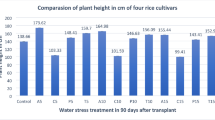Abstract
System of rice intensification was initially introduced to increase rice productivity in India, but is recently popularized as promising water saving practice. Sustaining rice productivity with minimal use of water is the need of the day. In this background, an experiment was designed to assess the effect of variable degrees of water stress namely no-stress, mild-stress and prolonged-stress imposed throughout the crop growth by scheduling irrigation at 1, 3 and 5 days, respectively after disappearance of ponded water under system of rice intensification with two different planting geometry and two contrasting varieties. Results clearly demonstrated that mild and prolonged stress during late vegetative stage (45–75 days after transplanting) greatly (P ≤ 0.05) enhanced (30.3–41.5 %) crop growth rate while, any level of stress during reproductive phase reduced (8.8–10.8 %) the rate of crop growth. Despite of higher tiller production under stress condition, large number of tillers failed to convert in ear-bearing tillers indicating higher tiller mortality under stress environment. Meanwhile, tiller density was not confirmed as a yield determinant while, the rice yield had higher correlation with grain weight panicle−1 (r = 0.743*), filled grain percentage (r = 0.806*), test weight (r = 0.683*) and nutrient uptake. With increase in stress intensity, apparent recovery of nutrients significantly (P ≤ 0.05) reduced, and the decline rate was in the order of potassium > phosphorus > nitrogen. Rice crop imposed mild-stress maintained at par yield (P > 0.05) with no stress, however prolonged-stress resulted in significant yield loss. Thus, mild-stress throughout the crop growth can reduce the water requirement and would be an effective water management strategy under water limited conditions.




Similar content being viewed by others
References
Barker R, Dawe D, Tuong TP, Bhuiyan SI, Guerra LC (2000) The outlook for water resources in the year 2020: challenges for research on water management in rice production. Int. Rice Commun Newsl 49:7–21
Murty MVR, Gujja B, Satyanarayana A, Rao P, Riddell P, Goud V (2006) Transforming irrigated rice cultivation for future food needs: The results of SRI trials in Andhra Pradesh. Paper for International Dialogue on Rice and Water: Exploring Options for Food Security and Sustainable Environments, IRRI, Los Baños, March pp 7–8
Shambu Prasad C (2006) System of Rice Intensification in India: Innovation History and Institutional Challenges. WWF International—ICRISAT Dialogue Project, Patencheru, Hyderabad, India
Dobermann A (2004) Critical assessment of the system of rice intensification (SRI). Agric Syst 79:261–281
Stoop W, Uphoff N, Kassam A (2002) A review of agricultural research issues raised by the system of rice intensification (SRI) from Madagascar: opportunities for improving farming systems for resource-poor farmers. Agric Syst 71:249–274
Stoop W, Adam A, Kassam A (2009) Comparing rice production systems: a challenge for agronomic research and for the dissemination of knowledge intensive farming practices. Agric Water Manag 96:1491–1501
Islam M, Nath LK, Patel DP, Das A, Munda GC, Samajdar T, Ngachan SV (2014) Productivity and socio-economic impact of system of rice intensification and integrated crop management over conventional methods of rice establishment in eastern Himalayas, India. Paddy Water Environ 12(1):193–202
Jackson ML (1973) Soil Chemical Analysis. Prentice Hall Pvt. Ltd., New Delhi 498
Gomez AKA, Gomez AA (1984) Statistical procedures for agricultural research. John Willey and Sons, New York 680
Vizier JF, De Giudici P, Raunet M (1990) A physical and chemical study of lowland soils in the highlands of Madagascar: consequences for rice cultivation. Agron Tropicale 45(3):171–177
Kar S, Varade SB, Subramanyam TK, Ghildyal BP (1974) Nature and growth pattern of rice root system under submerged and unsaturated conditions. Riso (Italy) 23:173–179
Katayama T (1951) Ine mugo no bungetsu kenkyu (Studies on tillering in rice, wheat and barley). Yokendo Publishing, Tokyo
Hobbs P, Morris M (1996) Meeting South Asia’s Future Food Requirements from Rice–Wheat Cropping Systems: Priority Issues Facing Researchers in the Post-Green Revolution Era. CIMMYT Natural Resources Group Paper, CIMMYT, Mexico City pp 96–101
Ladha JK, Dawas D, Pathak H, Padre AT, Yadav RL, Bijay Singh (2003) How extensive are yield decline in long-term rice-wheat experiments in Asia. Field Crop Res 81:159–180
Bhandari AL, Ladha JK, Pathak H, Padre AT, Dawe D, Gupta RK (2002) Yield and soil nutrient changes in a long-term rice-wheat rotation in India. Soil Sci Soc Am J 66:162–170
Zhang BG, Puard M, Couchat P (1990) Effect of hypoxia, acidity and nitrate on inorganic nutrition in rice plants. Plant Physio Biochem 28:655–661
Dobermann A, Dawe D, Roetter RP, Cassman KG (2000) Reversal of rice yield decline in a long-term continuous cropping experiment. Agron J 92(4):633–643
Prasad R (2009) Efficient fertilizer use: the key to food security and better environment. J Tropical Agric 47(1–2):1–17
Bouman BAM, Tuong TP (2001) Field water management to save water and increase its productivity in irrigated lowland rice. Agric Water Manag 49:11–30
Kropff MJ, Cassman KG, Peng S, Mathews RB, Setter TL (1994) Quantitative understanding of yield potential. In: Cassman KG (ed) Breaking the yield barrier. Int Rice Res Inst, Los Banos, pp 21–38
Acknowledgments
The research work was funded by All India Coordinated Research Project, Indian Council of Agricultural Research (ICAR). The authors are thankful to the anonymous reviewers for their comments and suggestions.
Author information
Authors and Affiliations
Corresponding author
Rights and permissions
About this article
Cite this article
Hazra, K.K., Chandra, S. Effect of Extended Water Stress on Growth, Tiller Mortality and Nutrient Recovery Under System of Rice Intensification. Proc. Natl. Acad. Sci., India, Sect. B Biol. Sci. 86, 105–113 (2016). https://doi.org/10.1007/s40011-014-0415-7
Received:
Revised:
Accepted:
Published:
Issue Date:
DOI: https://doi.org/10.1007/s40011-014-0415-7




